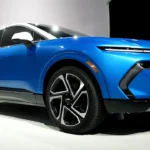Electric-car believers cheered when General Motors CEO Mary Barra told CNN that topping up an EV at home “costs pennies.”
Yet the same optimism can backfire: use the wrong electricity rate or forget a single step in the calculation, and you could quietly hand your utility $600 or more every year—wiping out most of the pump-to-plug savings you expected.
Below, we break down the real numbers, show you where the hidden costs lurk, and give you plain-English tools to keep your bill in check. (And yes, the headline phrase “Mary Barra Says Charging at Home Costs ‘Pennies’ — But One Simple Math Mistake Can Add $600 a Year to Your Power Bill” shows up right here to keep our SEO robot friends happy!)
1. Decoding Mary Barra’s “Pennies” Claim
1.1 Where and When She Said It
In a September 2023 sit-down with CNN, Barra emphasized that the “vast majority” of GM EV drivers juice up overnight and pay “pennies” per mile.
Her point? When you charge during off-peak hours at residential rates, the cost per mile can truly fall below three cents—less than one-fifth of what many drivers spend on gasoline per mile.
1.2 Pennies per Mile vs. Pennies per kWh
- Pennies per kWh is the raw electricity price.
- Pennies per mile takes efficiency into account (miles traveled ÷ kWh consumed).
Barra referenced pennies per mile, assuming off-peak pricing and efficient driving habits. But if you accidentally charge on-peak—or your utility bumps you into a higher tier—the “pennies” snowball fast.
2. What Home EV Charging Really Costs in 2025
2.1 Average U.S. Residential Electricity Price: 16.8 ¢/kWh
The U.S. Energy Information Administration pegs the 2025 average residential rate at 16.8 ¢/kWh.
At that price:
- A 60 kWh battery (e.g., Chevy Equinox EV) costs about $10 to fill.
- Driving 1,000 miles a month at 3 miles/kWh uses ~333 kWh → about $56 monthly.
2.2 Battery Size, Efficiency, and Weather Factors
- Bigger batteries = more kWh per fill-up, not always more range.
- Cold weather can slash efficiency by 10–40%.
- Home fast-chargers lose 5–10% of power to heat; build that into your math.
3. The $600 Math Mistake—Using the Wrong Rate Tier
3.1 Tiered & Time-of-Use Pitfalls
A 2024 fleet-charging study found that misreading tiered or time-of-use (TOU) rates can push reimbursement errors 10–20 ¢ per kWh higher than actual cost, per Automotive Fleet.
Multiply a 15,000-mile-per-year driver’s 5,000 kWh consumption by a 12 ¢ miscalculation and you overspend $600 annually—all from one tiny formula slip.
3.2 Real-World Example: Peak vs. Off-Peak Charging
| Scenario | kWh/Year | Price /kWh | Annual Cost |
|---|---|---|---|
| Off-Peak Only | 5,000 | $0.12 | $600 |
| Peak Hours (mistake) | 5,000 | $0.24 | $1,200 |
| Extra Paid | — | — | $600 |
All it takes is forgetting to set your charger’s timer or missing a fresh utility-rate email.
4. Step-by-Step: Calculate Your True Annual Charging Cost
4.1 Gather Your Utility Invoice Data
- Find your rate plan name (e.g., TOU-EV, Tier II Residential).
- Note each price bucket—both off-peak and peak.
- Download 12 months of usage to spot seasonal swings.
4.2 Factor In Charger Efficiency & Vampire Load
- Charger inefficiency: Add 8% to rated battery size.
- Standby/Vampire: Some EVs draw 1 kWh/day just sitting; that’s $61/year at 16.8 ¢/kWh.
- Pre-conditioning: Heating or cooling while plugged in can double session energy.
5. Five Proven Ways to Keep Costs in the “Pennies” Zone
5.1 Smart Schedules & Apps
Set a departure time in your vehicle app; most modern EVs delay charging until the cheapest window automatically.
5.2 Utility EV Discounts & Rebates
Many utilities give $0.05–$0.10 per kWh rebates for overnight charging or offer $400 smart-charger incentives. Check your provider’s EV portal.









